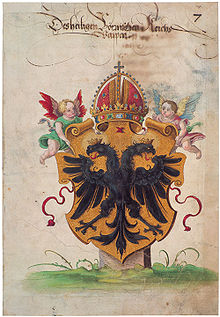 Global Information
Global InformationGerman heraldry information
 Manuscript illumination of historical coats of arms of the Holy Roman Empire, c. 1540 | |
| Heraldic tradition | German-Nordic |
|---|---|
| Governing body | None |
German heraldry is the tradition and style of heraldic achievements in Germany and the Holy Roman Empire, including national and civic arms, noble and burgher arms, ecclesiastical heraldry, heraldic displays and heraldic descriptions. German heraldic style is one of the four major broad traditions within European heraldry and stands in contrast to Gallo-British, Latin and Eastern heraldry, and strongly influenced the styles and customs of heraldry in the Nordic countries, which developed comparatively late. Together, German and Nordic heraldry are often referred to as German-Nordic heraldry.[1]
The German heraldic tradition is noted for its scant use of heraldic furs, multiple crests, inseparability of the crest, and repetition of charges in the shield and the crest. Mullets have six points (rather than five as in Gallo-British heraldry), and beasts may be colored with patterns, (barry, bendy, paly, chequy, etc.).[2]
As in other European heraldic traditions, the most prominent among the birds and beasts are the eagle and lion.[3] These two charges in particular had a special significance in Germany, where the eagle became symbolic of the Holy Roman Empire, and the lion came to represent certain feudal lords.[4] As the political divide between these groups grew in the late Middle Ages, the heraldic eagle and lion came to represent two of the foremost political powers in Germany, the house of Hohenstaufen and the house of Welf, respectively.
- ^ Volborth, Carl-Alexander von (1981). Heraldry: Customs, Rules and Styles. Poole, England: Blandford Press. ISBN 0-7137-0940-5. ISBN 0-7137-0940-5 p.129.
- ^ Kristina Pereya (2006-07-05). "A Collection of Period German Heraldry (1400–1600) for SCA Heralds". Academy of St. Gabriel. Retrieved 2009-01-18.
- ^ Neubecker, Ottfried (1979). A Guide to Heraldry. Maidenhead, England: McGraw-Hill. ISBN 0-07-046312-3. ISBN 0-07-046312-3 p.90.
- ^ Neubecker (1979), pp.90–91.